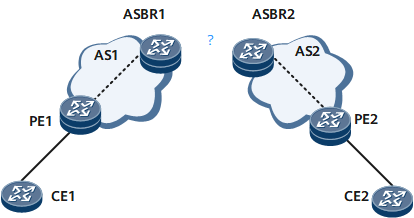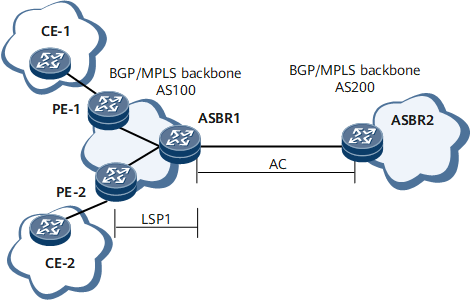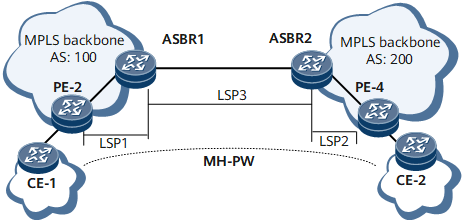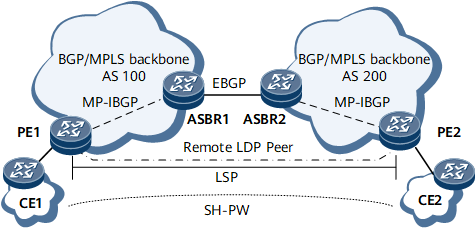Inter-AS VPWS
Definition
Inter-AS VPWS is an L2VPN technology that enables users to communicate across multiple autonomous systems (ASs).
Unlike inter-AS VLL, which provides inter-AS communication by setting a static LSP between autonomous system boundary routers (ASBRs), inter-AS VPWS is more like inter-AS L3VPN in terms of implementation.
In inter-AS VPWS Option A, the link type between ASBRs must be the same as the VC type. The disadvantage of inter-AS VPWS Option A is that each ASBR must reserve a sub-interface for each inter-AS VC. Inter-AS VPWS Option A applies to scenarios in which the number of inter-AS VCs is small. Compared with inter-AS L3VPN Option A, inter-AS VPWS Option A consumes more resources and requires more configuration workload.
In inter-AS VPWS Option C, the devices on a service provider network only need to set up an outer tunnel on PEs in different ASs; the ASBRs do not need to maintain information about inter-AS VPWS or reserve sub-interfaces for inter-AS VCs; L2VPN information is exchanged only between PEs. Compared with inter-AS VPWS Option A, inter-AS VPWS Option C consumes fewer resources and requires less configuration workload.
Purpose
With the popularity of MPLS VPN, the requirements for communication between the MANs of different carriers or between different backbone networks become common. As a result, inter-AS VPWS is introduced to solve the inter-AS communication problem.
On the L2VPN shown in Figure 1, some users belong to AS1, and some to AS2. If MPLS forwarding is not implemented, L2VPN users in different ASs cannot communicate. Figure 1 shows a scenario in which L2VPN users of only two ASs need to communicate. In reality, L2VPN users of more ASs may need to communicate.
Inter-AS VPWS Option A
In inter-AS VPWS Option A, ASBRs in two ASs are directly connected. The two ASBRs function as PEs in their respective ASs, but regard each other as a CE.
On the network shown in Figure 2, ASBR2 is a CE for ASBR1. Similarly, ASBR1 is a CE for ASBR2.
The characteristics of inter-AS VPWS Option A are as follows:
Easy to implement
MPLS forwarding is not required between the PEs functioning as ASBRs, because common IP forwarding can be adopted, and no special inter-AS configuration is required.
Poor scalability
- The PEs functioning as ASBRs need to manage information about all L2VPNs, which leads to a great deal of L2VPN information on the PEs and therefore burdens the PEs.
- An AC interface must be reserved for each PW, because the PE functions as an ASBR in the local AS.
- If users need to communicate across multiple ASs, intermediate ASs must support L2VPN. This causes heavy configuration and affects the intermediate ASs.
Inter-AS VPWS Option A applies to scenarios in which a VPWS network crosses only a few ASs.
Inter-AS Multi-segment PWE3
In inter-AS multi-segment PWE3, multi-segment PWs are set up. As shown in Figure 3, PW switching needs to be performed on two ASBRs, and an LDP session and a tunnel must be set up between the two ASBRs.
Compared with inter-AS VPWS Option A, inter-AS multi-segment PWE3 provides better scalability and has no limit to the number of links between ASBRs, because ASBRs exchange PW information over an LDP session rather than a private link.
Inter-AS multi-segment PWE3, however, has the following limitations:
- The PEs functioning as ASBRs need to manage information about all L2VPNs.
- If users need to communicate across multiple ASs, intermediate ASs must support L2VPN.
- LDP sessions and LSPs need to be set up between ASBRs.
Inter-AS VPWS Option C
The preceding two schemes require ASBRs to participate in the distribution and maintenance of PW labels. When multiple inter-AS PWs exist in each AS, ASBRs may be a bottleneck in network expansion.
Inter-AS VPWS Option C avoids this problem by freeing ASBRs from setting up and maintaining PWs. PW labels are directly switched between PEs, as shown in Figure 4.
In inter-AS VPWS Option C:
ASBRs advertise labeled IPv4 routes to PEs in their respective ASs through Multiprotocol Interior Border Gateway Protocol (MP-IBGP), and advertise labeled IPv4 routes received by PEs in their respective ASs to the ASBR peers in other ASs. ASBRs in the intermediate AS also advertise labeled IPv4 routes. As a result, an BGP LSP is set up between the ingress PE and the egress PE.
PEs in different ASs set up remote MPLS LDP sessions to exchange PW information.
Inter-AS VPWS Option C has the following advantages:
Similar to the network on which L2VPN users belong to the same AS, intermediate devices do not need to store L2VPN information.
Only PEs need to store L2VPN information. The devices in intermediate ASs only need to function as ordinary ASBRs that support IP forwarding and do not need to support L2VPN. Inter-AS VPWS Option C is preferred when users need to communicate across a large number of ASs.



